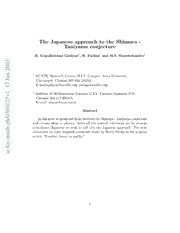
The Japanese approach to the Shimura - Taniyama conjecture PDF
Preview The Japanese approach to the Shimura - Taniyama conjecture
The Japanese approach to the Shimura - Taniyama conjecture H. Gopalkrishna Gadiyar1, R. Padma1 and H.S. Sharatchandra2 3 0 0 2 n 1 AU-KBC Research Centre, M.I.T. Campus, Anna University, a J Chromepet, Chennai 600 044 INDIA 7 E-mail:[email protected], [email protected] 1 1 2 Institute of Mathematical Sciences, C.I.T. Campus,Taramani P.O., v 3 Chennai 600 113 INDIA 2 E-mail: [email protected] 0 1 0 Abstract 3 0 / InthisnotewepointoutlinksbetweentheShimura-Taniyamaconjecture h p and certain ideas in physics. Since all the seminal references are by strange - h coincidence Japanese we wish to call this the Japanese approach. The note at elaborates on some inspired comments made by Barry Mazur in his popular m article “Number theory as gadfly.” : v i X r a 1 In his article “Number theory as gadfly” [1], Barry Mazur makes certain perceptive comments: As I shall not have the time to make clear, but hope, atleast to make believable, the conjecture of Shimura - Taniyama - Weil is a profoundly unifying conjecture - its very statement hints that we may have to look to diverse mathematical fields for insights or tools that may lead to its resolution. It does not seem unnatural to look to differential geometry for progress with this conjecture, or to partial differential equations and the study of the eigen value problem for elliptic operators, or to the representation theory of reductive groups.... It would be no surprise if ideas from the classical theory of one complex variable and the Mellin transform were relevant, or of Algebraic Geometry .....But perhaps one should also look in the direction of Kac - Moody algebras, loop groups or D - modules, perhaps to ideas that have been, or will be, imported from Physics...... In this note we point out that such a connection can be easily made. The comments quoted above can be sharpened to the use of the techniques of formal groups, conformal field theory and the theory of nonlinear differential equations. We view the essence of the Shimura - Taniyama conjecture as extracting arithmetical information from a geometric object defined analytically. An elliptic curve is essentially defined given a function ℘(z). As this function obeys a nonlinear differential equation it is evident that the theory of non- linear differential equations would be an essential tool. TheconjectureofShimura-Taniyamasaysthatthereisanotherparametriza- tion which contains arithmetical information. This is given by the mapping [2] ∞ a(n) 2πinz α(z) = ℘(X e ) n n=1 ∞ a(n) ′ 2πinz β(z) = ℘(X e ) n n=1 The a(n) are the objects encoding arithmetical information. We wish to point out that the theory of the KP - hierarchy provides the key to linking the Shimura - Taniyama parametrization to the theory of soliton equations. In the KP - hierarchy the essential object of study is the 2 ∞ so called τ function which is essentially θ(Pk=1aktk). This has already been used to settle the Schottky problem by Mulase [3] and Shiota [4]. The next ingredient is the theory of formal groups. Honda [5, 6] showed theisomorphismbetweentheformalgrouparisingfromtheanalyticparametriza- tion and the formal group arising from the arithmetical parametrization. In fact, he has even provided explicit constructions. Finally the connection be- tween formal groups and the τ function has been made in the paper [7]. In this paper Hecke like operators are constructed. It essentially involves map- pings of the tk. One can construct the strict analogue of Hecke operators also. Hence the observations of Barry Mazur can be made precise. Essentially onegoesfrom℘(z) totheτ functionwhich containsarithmeticalinformation. It is well known that the τ function is linked to a rich variety of math- ematical objects like conformal field theory, infinite dimensional Lie groups, vertex operators, and so on fulfilling Barry Mazur ’s predictions. The refer- ences given are those that influenced the authors and are not meant to be exhaustive. We have written this brief version to enable the community of mathemat- ical physicists to develop what seems a rich mine. GHG wishes to thank Professor N. D. Haridass for introducing him to the work of Miwa, Jimbo and Date [8]. References 1 B. Mazur, Number theory as gadfly, Amer. Math. Monthly, 98(1991), 593-610 2 D. Goldfeld, Modular elliptic curves and Diophantine problems, Num- ber Theory, Proceedings of the First Conference of the Canadian Num- ber theory Association held at the Banff Centre, Banff, Alberta, April 17-27, 1988, R. Mollin (Ed.), Walter de Gruyter Inc., 157-175 3 M. Mulase, Cohomological soliton equations and Jacobian varieties, J. Diff. Geom., 19 (1984), 403-430 4 T. Shiota, Characterization of Jacobian varieties in terms of soliton equations, Invent. Math. 83(1986), 333-382 3 5 T. Honda, Formal groups and zeta functions, Osaka J. Math. 5 (1968), 199-213 6 T. Honda, Invariant differentials and L-functions. Reciprocity law for quadratic fields and elliptic curves over Q, Rend. Sem. Math. Univ. Padova 49 (1973), 323-335 7 T. Katsura, Y. Shimizu, amd K. Ueno, Formal groups and conformal field theory over Z, Advanced Studies in Pure Mathematics 19, 1989, Integrable Systems in Quantum Field Theory and Statistical Mechan- ics, Kinokuniya Shoten and Academic Press, 347-366 8 T. Miwa, M. Jimbo and E. Date, Solitons: Differential equations, sym- metries and infinite dimensional algebras, Cambridge University Press, 2000 4
